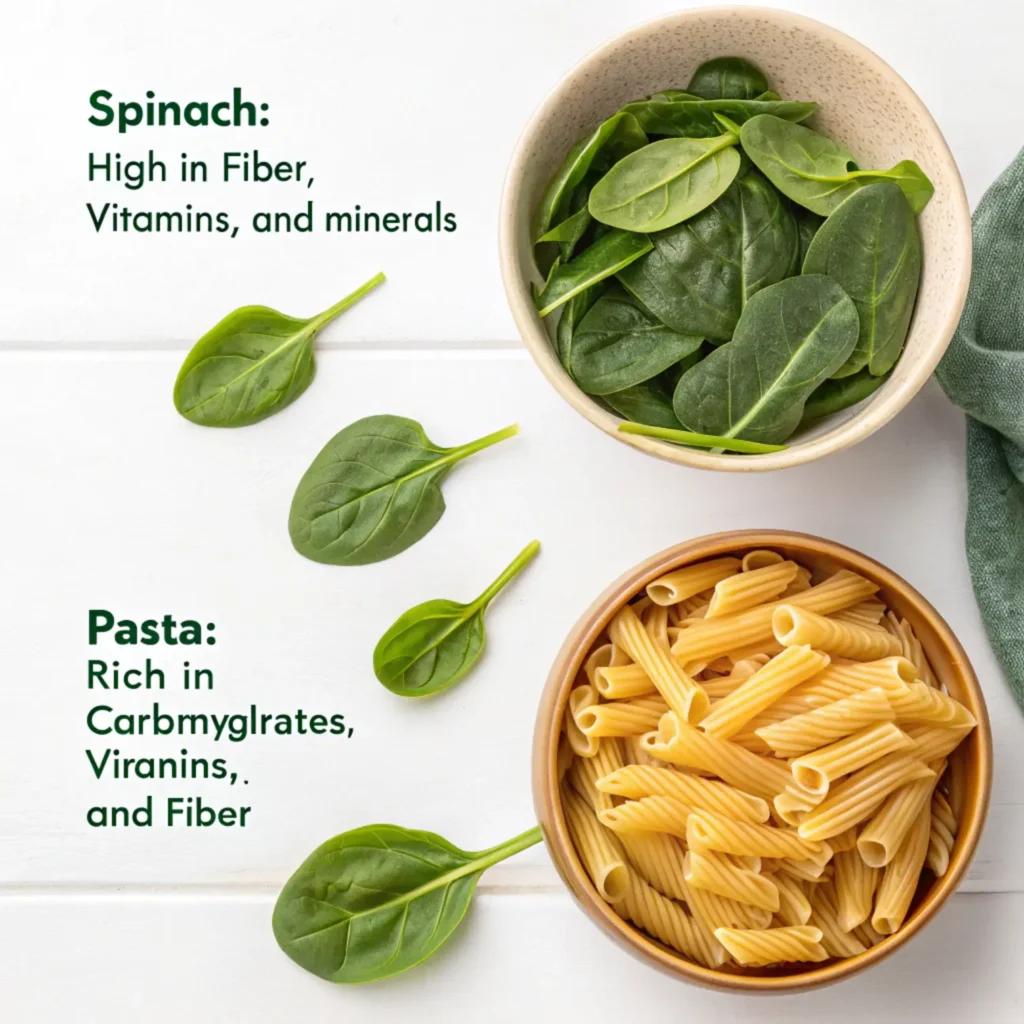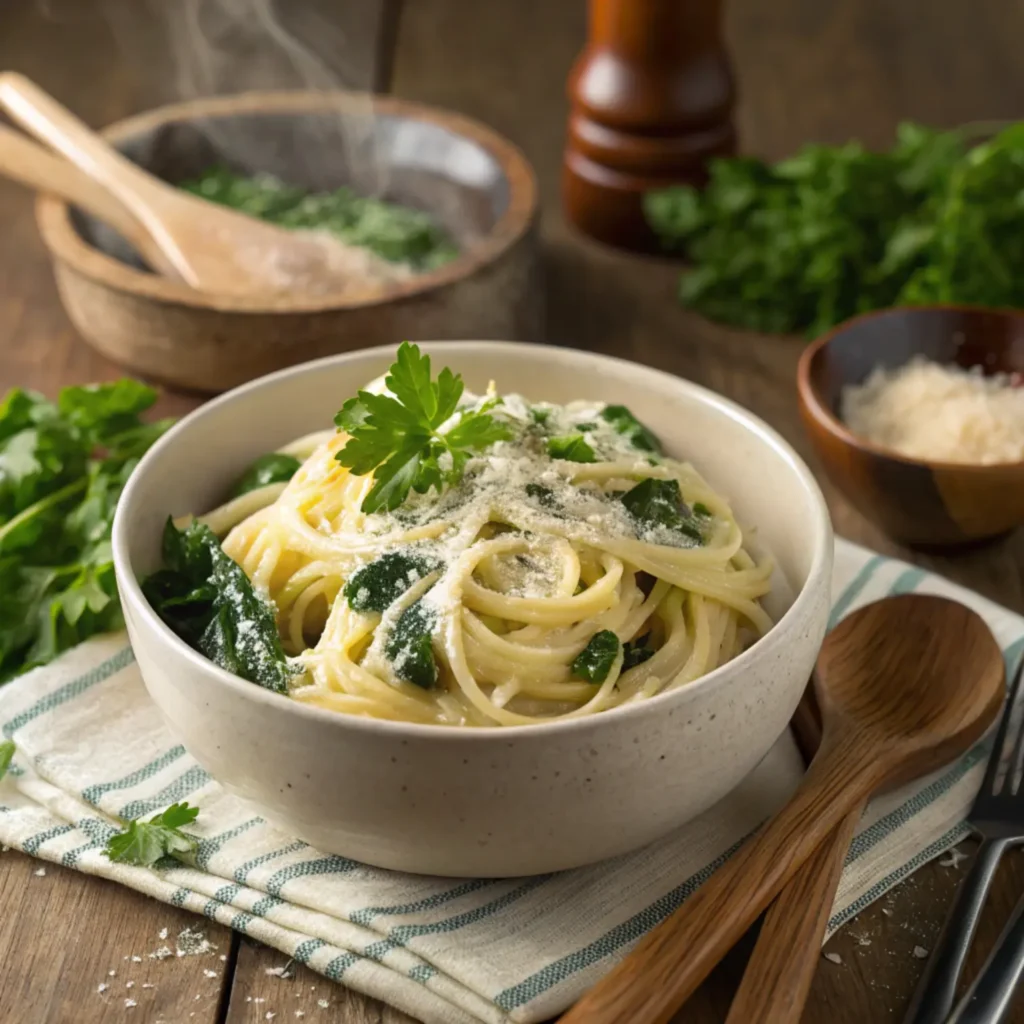Adding spinach to pasta is a simple way to make your meals healthier and more nutritious. Spinach, with its rich supply of vitamins and antioxidants, complements pasta’s comforting carbohydrates, creating a balanced dish. But does adding spinach to pasta truly make it healthier? Throughout this article, we’ll dive deep into the health benefits, practical tips, and common concerns about combining these two ingredients.
What Is Spinach and Why It’s a Powerhouse Ingredient?
Spinach, a leafy green vegetable renowned for its dense nutrient profile, has been a dietary staple for centuries. Packed with antioxidants, vitamins, and minerals, it holds a coveted place in health-conscious diets. But what makes this humble green so beneficial?
Nutritional Benefits of Spinach
Spinach is a treasure trove of essential nutrients. It boasts high levels of vitamin A for eye health, vitamin K for blood clotting, and folate to support cell growth and repair. Iron and calcium also stand out, contributing to improved energy levels and bone health, respectively. Not to mention, spinach is low in calories but abundant in dietary fiber, which promotes gut health and aids digestion.
- Vitamins and Minerals
With its mix of vitamin C, potassium, and magnesium, spinach helps boost immunity and maintain optimal heart health. It also contains lutein and zeaxanthin—antioxidants that protect your eyes from harmful light exposure. - Antioxidant Properties
Spinach is loaded with powerful antioxidants, such as flavonoids and carotenoids, which help neutralize free radicals. These compounds play a crucial role in reducing inflammation and lowering the risk of chronic diseases like heart disease and cancer.
Why Spinach Pairs Well with Pasta
Spinach and pasta might seem like an unusual pairing at first glance, but they complement each other exceptionally well. Pasta serves as a satisfying base, while spinach adds depth, flavor, and nutrients. Its mild, slightly earthy taste blends seamlessly with sauces, enhancing the overall dish without overpowering it.
Nutritional Composition of Pasta
Pasta, a cornerstone of countless cuisines, is a versatile and delicious food that forms the foundation of many meals. While its nutritional profile varies depending on the type, pasta remains a reliable source of energy and carbohydrates. Let’s delve deeper into what makes pasta an essential food choice and how pairing it with spinach enhances its health benefits.
Macronutrient Breakdown
Pasta primarily provides carbohydrates, which serve as the body’s main energy source. A typical serving offers:
- Carbohydrates: Essential for fueling the brain and muscles.
- Protein: Small amounts of protein contribute to muscle repair and overall tissue health.
- Fats: Traditional pasta has minimal fat, making it a great option for low-fat diets.
But not all pasta is created equal! For example, whole-grain pasta contains more fiber and protein than its refined counterpart, helping maintain steady blood sugar levels and promoting satiety.
Whole Grain vs. Refined Pasta
- Whole Grain Pasta: Packed with dietary fiber, B vitamins, and minerals, whole-grain pasta provides longer-lasting energy and supports digestive health. Pairing it with spinach further amplifies its fiber content, creating a nutrient-dense meal.
- Refined Pasta: While lighter and quicker to cook, refined pasta lacks some essential nutrients. Adding spinach helps compensate for this by boosting the dish’s overall nutritional value, especially with antioxidants and vitamins.
How Pasta Supports Spinach’s Nutrients
The combination of pasta and spinach isn’t just about taste—it’s about synergy. Pasta’s carbohydrate content offers a steady energy source that complements the fiber and nutrient density of spinach. When cooked together, the pairing ensures a balance of macronutrients and micronutrients in a single dish.
For example, the non-heme iron found in spinach can be better absorbed when paired with vitamin C-rich pasta sauces like marinara. This creates an ideal environment for your body to make the most of both ingredients.
Health Benefits of Combining Spinach and Pasta
Pairing spinach with pasta is more than just a culinary choice—it’s a smart nutritional decision. Together, they create a meal that’s not only satisfying but also brimming with essential nutrients. Let’s explore the remarkable health benefits of this duo.
Enhanced Fiber Content
Spinach significantly increases the dietary fiber in pasta dishes. While pasta alone has moderate amounts of fiber (especially whole grain varieties), adding spinach provides an extra boost that:
- Supports healthy digestion by preventing constipation.
- Helps maintain stable blood sugar levels.
- Encourages a feeling of fullness, aiding in weight management.
A meal combining these two ingredients can help keep hunger at bay while nourishing your gut.

Improved Micronutrient Density
When you add spinach to pasta, the dish transforms into a nutrient powerhouse. Spinach provides vital micronutrients that pasta lacks, such as:
- Vitamin K: Essential for bone health and proper blood clotting.
- Folate: Supports cell function and DNA synthesis.
- Magnesium: Promotes muscle relaxation and supports nerve health.
This harmonious pairing ensures you’re getting a more comprehensive nutrient profile in every bite.
Antioxidant Boost
The antioxidants in spinach, including lutein and beta-carotene, work to neutralize free radicals in the body. When combined with pasta, particularly whole-grain varieties, these antioxidants:
- Reduce inflammation.
- Support cardiovascular health.
- Help lower the risk of chronic illnesses like heart disease and diabetes.
Moreover, the quick cooking time of spinach ensures that most of these antioxidants remain intact.
Blood Sugar Regulation
Adding spinach to pasta can also influence the dish’s glycemic index. While refined pasta might cause a quick spike in blood sugar levels, spinach’s fiber content helps slow digestion, resulting in:
- Steadier energy release.
- Better blood sugar control for individuals managing diabetes.
This balance makes spinach an excellent addition to pasta, especially for those who love comfort food but want to keep it healthy.
Weight Management Benefits
The low-calorie nature of spinach combined with the high satiety of pasta creates a meal perfect for weight management. Spinach’s high water content and fiber keep you feeling full, while pasta’s carbohydrates provide the energy to stay active throughout the day.
Practical Ways to Add Spinach to Pasta Dishes
Incorporating spinach into pasta dishes doesn’t have to be a chore. With a few simple techniques, you can elevate your meals, adding both flavor and nutrition. Whether you prefer fresh or frozen spinach, the possibilities are endless!
Fresh vs. Frozen Spinach
- Fresh Spinach:
Fresh spinach offers a vibrant color and tender texture that complements pasta dishes beautifully. To use it:- Rinse thoroughly to remove dirt.
- Add it directly to the pasta in the last minute of cooking for a wilted, fresh taste.
- Use it raw in pasta salads for a refreshing crunch.
- Frozen Spinach:
Frozen spinach is a convenient alternative that retains most of its nutrients. It’s perfect for creamy sauces or baked pasta dishes. Simply:- Thaw and drain excess water to avoid sogginess.
- Sauté with garlic and olive oil for a flavorful topping.
Cooking Techniques for Spinach and Pasta
Cooking spinach with pasta isn’t just easy—it’s foolproof. Here are a few techniques to get you started:
- Sautéing:
Heat a pan with olive oil, toss in minced garlic, and add spinach. Cook just until wilted, then mix into your pasta for a burst of flavor. - Blending:
For a creamy spinach sauce, blend cooked spinach with a splash of cream or dairy-free alternative, parmesan, and seasonings. Toss it with pasta for a luscious, nutrient-rich dish. - Layering in Bakes:
Add spinach between layers of lasagna or baked ziti for a delicious and nutrient-packed casserole.
Pairing Spinach with Complementary Ingredients
Spinach pairs wonderfully with a variety of ingredients, making it a versatile addition to pasta dishes:
- Proteins: Add grilled chicken, shrimp, or plant-based alternatives for a balanced meal.
- Vegetables: Combine spinach with mushrooms, cherry tomatoes, or artichokes for extra color and nutrients.
- Cheeses: Spinach loves the creaminess of ricotta, feta, or parmesan, adding richness without overwhelming the dish.
By using these techniques and pairings, you’ll never run out of ideas for incorporating spinach into pasta.

Addressing Common Concerns About Spinach
While spinach is undeniably a nutrient-rich addition to pasta, some concerns arise regarding its components. Let’s tackle these questions to help you fully embrace spinach in your dishes.
Oxalates in Spinach and Their Effects
Spinach contains natural compounds called oxalates, which can bind with calcium and form crystals in the body. These oxalates are sometimes linked to kidney stones or reduced calcium absorption.
- What Are Oxalates?
Oxalates are organic acids found in many leafy greens, including spinach. While they’re harmless for most people, individuals prone to kidney stones may want to limit their intake. - How to Reduce Oxalates?
Cooking spinach significantly reduces its oxalate content. For example:- Blanch spinach briefly and drain the water to remove excess oxalates.
- Pair spinach with calcium-rich foods like dairy to offset the binding effect.
Spinach and Iron Absorption
Spinach is often lauded for its iron content, but it contains non-heme iron, which is less readily absorbed by the body compared to the iron found in animal products.
- Improving Iron Absorption from Spinach
To maximize the iron your body absorbs:- Pair spinach with vitamin C-rich foods like tomatoes, bell peppers, or lemon juice.
- Avoid consuming spinach with tea or coffee during meals, as tannins can inhibit iron absorption.
- Spinach and Anemia
While spinach alone may not meet all iron needs, especially for those with anemia, it’s a valuable contributor when paired with other iron-rich foods or supplements.
Balance Is Key
Despite these concerns, the benefits of spinach far outweigh its limitations for most people. By preparing spinach correctly and pairing it wisely, you can enjoy its nutrients without worry.
FAQs About Adding Spinach to Pasta
Spinach is a popular addition to pasta, but it raises some common questions among home cooks. Let’s address these FAQs to help you make the most of this nutritious pairing.
Is spinach pasta healthier than regular pasta?
Yes, spinach pasta is generally healthier than regular pasta because it incorporates spinach into the dough, adding nutrients like iron, vitamin K, and antioxidants. However, it’s essential to check the label for actual spinach content, as some brands use minimal amounts. Pairing regular pasta with fresh spinach can be just as nutritious.
Can you put spinach in spaghetti?
Absolutely! Spinach works wonderfully in spaghetti dishes. You can toss fresh spinach directly into the spaghetti during the last minute of boiling or sauté it separately with olive oil and garlic. Spinach adds a vibrant color and a mild earthy flavor to spaghetti, making it more appealing and nutritious.
When should you add spinach to pasta?
The timing depends on how you’re using spinach:
- For fresh spinach, add it during the last minute of pasta boiling for a quick wilt.
- For frozen spinach, cook it separately and stir it into the pasta sauce or the finished dish.
This approach ensures spinach retains its texture and nutrients.
How do you add spinach to pasta sauce?
Spinach can be incorporated into pasta sauces in several ways:
- Chop fresh spinach finely and stir it into the sauce during the last few minutes of cooking.
- Blend spinach into creamy sauces for a smooth, green texture.
- Sauté spinach with garlic and mix it into tomato-based sauces for extra flavor and fiber.
Does spinach change the taste of pasta?
Spinach has a mild, slightly earthy taste that blends well with most pasta dishes. It enhances the overall flavor without overpowering the dish. For those new to spinach, combining it with cheese, garlic, or a creamy sauce can help balance the flavor.
Can adding spinach to pasta help with weight loss?
Yes, spinach can aid in weight loss when paired with pasta. Its high fiber content promotes a feeling of fullness, reducing the likelihood of overeating. Additionally, spinach is low in calories but rich in nutrients, making it an excellent addition to calorie-conscious meals.

Final Thoughts
Adding spinach to pasta is a simple and effective way to elevate both the nutritional value and flavor of your meals. This versatile leafy green brings a wealth of vitamins, minerals, and antioxidants to the table, making your pasta dishes healthier without compromising taste.
Why You Should Add Spinach to Pasta
From improving the dish’s fiber content to supporting blood sugar regulation, spinach complements pasta beautifully. It’s also incredibly adaptable—whether you’re sautéing it, blending it into sauces, or tossing it fresh, there’s no shortage of ways to incorporate spinach into your favorite pasta recipes.
Balancing Flavor and Nutrition
Spinach’s mild, earthy flavor enhances pasta dishes without overwhelming them. Pairing spinach with complementary ingredients like garlic, cherry tomatoes, or parmesan cheese ensures a perfect balance of taste and health benefits.
A Sustainable Choice
Spinach is widely available, affordable, and easy to prepare, making it an accessible option for most households. By integrating spinach into your pasta dishes, you’re not only nourishing your body but also embracing sustainable, plant-forward eating habits.
Key Takeaways: Adding spinach to pasta isn’t just about nutrition—it’s about creating meals that are flavorful, satisfying, and rich in health-boosting properties. So next time you’re cooking pasta, why not toss in a handful of spinach? Your body (and your taste buds) will thank you.
Pro Tip: For more information about the nutritional benefits of spinach, visit Healthline.

